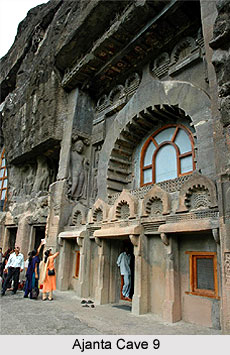 Ajanta Cave 9 is oblong on plan, and this small chaitya-griha, with its well-balanced facade, is divided into a nave, an apse and aisles by a colonnade of twenty-three pillars. At the centre of the apse stands a globular stupa on a high cylindrical base. The crowning members consist of a railing and a harmika, the latter expanded above into the shape of an inverted stepped pyramid. Over the harmika were wooden umbrellas, as attested by the existence, on the top, of two sockets meant for receiving the shafts. Except the two pillars near the entrance, the columns are plain slightly-tapering octagons without any base or capital; they support a triforium, from the top of which springs the vaulted ceiling.
Ajanta Cave 9 is oblong on plan, and this small chaitya-griha, with its well-balanced facade, is divided into a nave, an apse and aisles by a colonnade of twenty-three pillars. At the centre of the apse stands a globular stupa on a high cylindrical base. The crowning members consist of a railing and a harmika, the latter expanded above into the shape of an inverted stepped pyramid. Over the harmika were wooden umbrellas, as attested by the existence, on the top, of two sockets meant for receiving the shafts. Except the two pillars near the entrance, the columns are plain slightly-tapering octagons without any base or capital; they support a triforium, from the top of which springs the vaulted ceiling.
In the two central columns and the six pilasters of the door and windows can be seen an effective device of finishing off the arras at the point of transition between the square and octagon - a characteristic feature of the second and first centuries BC.
The ceiling of the aisles, lighted by two small windows, is flat. The vaulted ceiling of the nave and apse was originally braced with superfluous wooden beams and rafters; the holes meant for their insertions can be seen on the top of the triforium. The facade is dominated by a ribbed chaitya-window, originally ornamented with wooden lattice works, a rough idea of which can be gathered from the five chaitya-window motifs above the cornice over the doorway and window.
The chaitya-griha has been assigned to the first century BC. The figures of Lord Buddha on the facade and side-walls facing the court were, however, added at a much later date.Within the cave there are at places two layers of paintings, the earlier going back to the period of the excavation. It was a common practice amongst ancient artists to paint over an existing painting without completely rubbing it off. An idea of the superimposition of the later painting on the earlier one can be had on the inner side of the front wall above the left window and the door and the left wall.
In the older painting can be made out two groups of figures separated from each other by rocks. The left group presents only two Nagas seated under a tree in the rocky shelter; the one having multiple cobra-hoods is most probably the Naga king. The right group, which is much damaged, centres round a king, who seems to be listening to the petitions of a group of five persons seated near his throne. A couple is standing to the left of the seated figures, while a flying figure can be seen above hovering towards the assembly. The coiffures, ornaments and costumes of these figures are similar to contemporary relief at Sanchi Stupa.
Again, in the extreme left panel on the left wall one can come across a later painting, the persons of six Buddhas, beyond which there can be found an earlier painting consisting of a procession of devotees towards a stupa enclosed by walls closely resembling the gateways of Sanchi. Beyond the gateway is a structure, probably intended for a monastery.
The remnant of another old painting partly survives on the frieze above the left colonnade of the nave, where the movement of animals hotly chased by herdsmen is very realistically and forcefully portrayed.
The favourite motifs of the later painters are the figures of Buddha in various attitudes. The ceiling of the aisles is decorated with lotuses in panels. Twelve painted records have been noticed here.
Beyond this cave, at a slightly higher level to the right of the modern stairs, are two recesses with their walls relieved with the figures of Buddha.




